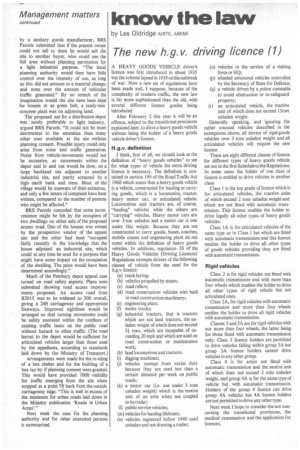know the law
Page 58

If you've noticed an error in this article please click here to report it so we can fix it.
by Les Oldridge AIRTE, AMIMI
The new h.g.v. driving licence (1)
A HEAVY GOODS VEHICLE driver's licence was first introduced in about 1935 but the scheme lapsed in 1939 on the outbreak of war. Now a new set of regulations have been made and, I suppose, because of the complexity of modern traffic, the new law is far more sophisticated than the old, with several different licence grades being introduced, After February 2 this year it will be an offence, subject to the transitional provisions explained later, to drive a heavy goods vehicle without being the holder of a heavy goods vehicle driver's licence.
H.g.v. definition I think, first of all, we should look at the definition of "heavy goods vehicles" to see for what types of vehicle the extra driving licence is necessary. The definition is contained in section 199 of the Road Traffic Act 1960 which states that a heavy goods vehicle is a vehicle, constructed for hauling or carrying goods, which is a locomotive, tractor, heavy motor car, or articulated vehicle. Locomotives and tractors are, of course, "hauling" vehicles while the others are "carrying" vehicles. Heavy motor cars are over 3-ton unladen and a motor car is one under this weight. Because they are not constructed to carry goods, buses, coaches, mobile cranes and engineering plant do not come within the definition of heavy goods vehicles. In addition, regulation 28 of the Heavy Goods Vehicles (Driving Licences) Regulations exempts drivers of the following classes of vehicle from the need for the h.g.v. licence: (a) track laying; (b) vehicles propelled by steam; (c) road rollers; (d) road construction vehicles with built in road construction machinery; (e) engineering plant; (f) works trucks; (g) industrial tractors, that is tractors which are not land tractors, the unladen weight of which does not exceed 3+ tons, which are incapable of exceeding 20 mph and which are used on road construction or maintenance work; (h) land locomotives and tractors; (i) digging machines; (j) vehicles exempt from excise duty because they are used less than a certain distance per week on public roads; (k) a motor car (i.e. one under 3 tons unladen weight) which is the motive unit of an attic when not coupled to its trailer; public service vehicles; (m) vehicles for hauling lifeboats; (n) vehicles registered before 1940 used unladen and not drawing a trailer;
(0) vehicles in the service of a visiting force or HQ;
(P) wheeled armoured vehicles controlled by the Secretary of State for Defence;
(a) a vehicle driven by a police constable to avoid obstruction or to safeguard property;
(r) an articulated vehicle, the tractive unit of which does not exceed 15cwt unladen weight.
Generally speaking, and ignoring the rather unusual vehicles described in the exemptions above, all drivers of rigid goods vehicles over 3 tons unladen weight and all articulated vehicles will require the new licence.
There are eight different classes of licence for different types of heavy goods vehicle set out in the first Schedule to the Regulations. In some cases the holder of one class of licence is entitled to drive vehicles in another class.
Class 1 is the top grade of licence which is for articulated vehicles, the tractive units of which exceed 2 tons unladen weight and which are not fitted with automatic transmission. This licence enables the holder to drive legally all other types of heavy goods vehicles.
Class IA is for articulated vehicles of the same type as in Class 1 but which are fitted with automatic transmission and this licence entitles the holder to drive all other types of goods vehicles providing they are fitted with automatic transmission.
Rigid vehicles Class 2 is for rigid vehicles not fitted with automatic transmission and with more than four wheels which enables the holder to drive all other types of rigid vehicle but not articulated ones.
Class 2A, for rigid vehicles with automatic transmission and more than four wheels entitles the holder to drive all rigid vehicles with automatic transmission.
Classes 3 and 3A are for rigid vehicles with not more than four wheels, the latter being for those fitted with automatic transmission only. Class 3 licence holders are permitted to drive vehicles falling within group 3A but group 3A licence holders cannot drive vehicles in any other group.
Class 4 is for attics not fitted with automatic transmission and the motive unit of which does not exceed 2 tons unladen weight, and group 4A is for the same type of vehicle but with automatic transmission. Holders of the group 4 licence can drive group 4A vehicles but 4A licence holders are not permitted to drive any other type.
Next week I hope to consider the law concerning the transitional provisions, the medical examination and the application for licences.








































































































